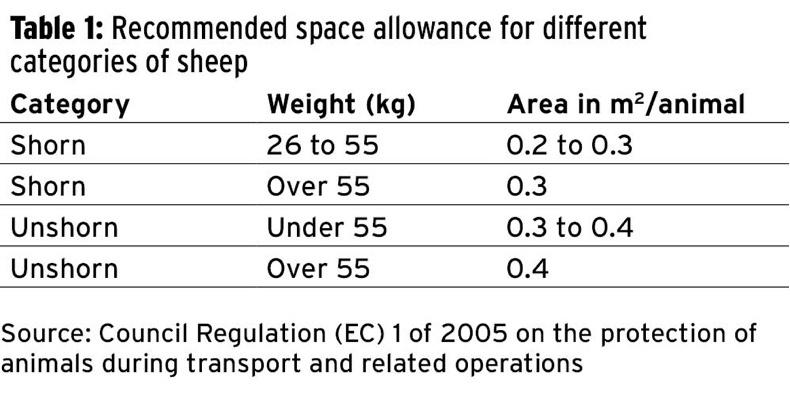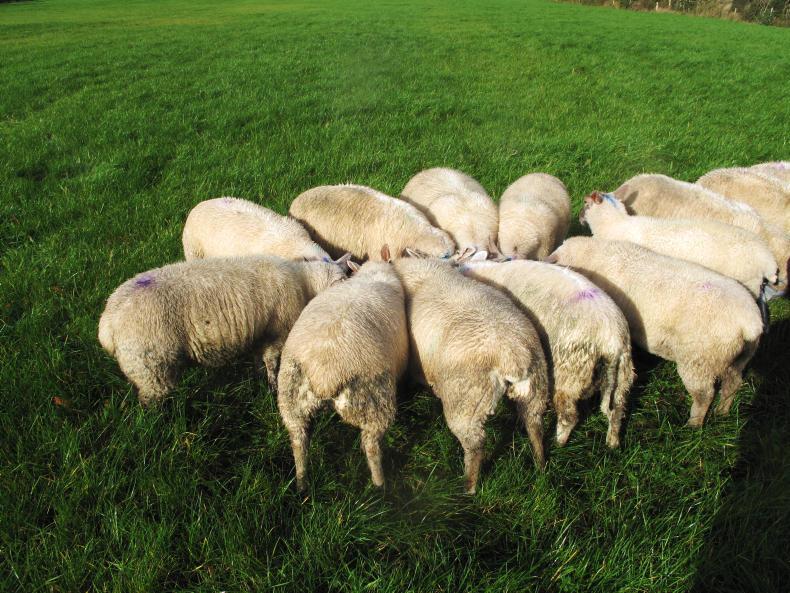Farmers are the first port of call in the clean livestock policy. If sheep leave the farm in a poor condition then there is a much greater risk of animals being rejected for slaughter. The Department’s clean livestock policy contains advice to reduce the risk of sheep ending up in category B and category C. Teagasc has also put together two guideline documents – one for farmers and one for hauliers or those transporting sheep. The main messages from these are included in the following article.
Finishing at grass
Drafting lambs from a grass-based diet is the most common finishing system practiced in Ireland. The following recommendations can help:
Where possible, maintain dry underfoot conditions and move finishing lambs to clean pasture when swards become muddy. Target drier areas for grazing in the run-up to slaughter.Excess nitrogen fertiliser or very lush grass will bring about more scouring, with the advice to avoid such conditions during the finishing stage.If supplementing, move troughs or feeders regularly to limit poaching and fleece contamination.Situate drinkers at a height and on drier areas, providing hardcore areas if needed to keep areas mud-free.Avoid routine free access to mineral supplements and instead treat animals for specific mineral and vitamin deficiencies.If conditions are not suitable to draft lambs straight off grass, then there may be no option but to house animals temporarily.Forage/root crops
Finishing lambs on forage crops became more popular in the last two years given the increased availability of forage crops planted to meet cross-compliance and the Green Low-Carbon Agri-Environmental Scheme (GLAS) requirements.
Inclement weather has restricted opportunities for shearing lambs. Teagasc advises crutching or dagging lambs before turning on to crops.
Sheep should be allowed time to adjust to the new diet by restricting access and providing a grass runback or free access to hay.
Similar to supplementation at grass, if supplementing with concentrates or hay, move feeding points regularly to avoid poaching.
Sheep should have a dry lying area to limit soiling of the fleece. On free-draining soils, the crop itself may provide this. On heavy soils, or during wet weather, Teagasc advises that a grass runback or straw-bedded area should be provided.
Finishing indoors
Animals should be finished in a well-ventilated shed that is suitable for the job at hand.
Shearing will help to keep lambs cleaner, but is not vital. Trials have shown no increase in animal performance between shorn and unshorn lambs.
In straw-bedded sheds, replenishing straw regularly and adhering to recommended stocking rates will help greatly.
In slatted sheds, ensuring slats do not become blocked is important in preventing a build-up of soiled material.
Allow adequate space at troughs and keep on top of any lameness issues.
Try to house animals dry.
Selecting the most appropriate finishing diet
The finishing diet offered can have a significant influence on the cleanliness of lambs. There has been a sharp increase in recent weeks in the number of farmers supplementing finishing lambs, with the aim of combating the low dry matter content and lower feeding value of grass along with improving daily liveweight and slaughter performance. The following Teagasc recommendations can help prevent feeding issues related to high-concentrate finishing diets.
Increase levels of concentrates slowly and avoid sudden changes to the diet to prevent dietary upsets and scouring.
Avoid feeding low dry matter diets (low DM silage, beet, etc).
Feed rations that are properly balanced for fibre, energy and protein.
Avoid feeding excess salt, as this increases water intake and urine production. Note also to include ammonium chloride at 0.5% of the finishing diet to protect against urinary calculi.
If feeding high-starch diets, avoid finely ground ingredients – feed a percentage of the cereal in whole or cracked form.
Pre-sale management and
transport advice
The way animals are managed in the run-up to sale can have a big bearing on their suitability for slaughter. Firstly, animals should be handled in an environment that gives the best opportunity to prevent fleece contamination.
Handling animals on straw bedding, slats or appropriate bedding will deliver more suitable working conditions than concrete or a soiled hardcore area, for example.
Where animals have been grazing on wet underfoot and muddy conditions, then the best option may be to house animals and allow time for the fleece to dry out. Processors can better handle animals that are dry and somewhat soiled over those that are soiled and wet. Lambs with dirty tail-ends should be dagged.
It is advisable to withdraw feed before transport, as this will greatly cut down on the potential for lambs to soil one another. Teagasc recommends withdrawing feed for a minimum of eight hours and a maximum of 12 hours, with animals offered free access to water at all times. For animals travelling long distances, it is important to liaise with your processor.

Lambs transported incorrectly can put the entire group at risk of failing to meet the required cleanliness. For example, one lamb with a dirty tail-end or scouring can contaminate the fleece of many more, particularly if lambs are wet when loading. For this reason, it is important to adhere to the recommendations listed above. The Teagasc guidelines below are also important to follow:
Only clean stock deemed fit for transport should be loaded.Only persons with experience of moving or handling stock should be involved in loading and unloading. Ensure correct handling to maintain animal welfare and avoid carcase damage.Avoid mixing groups or batches of livestock and use solid partitions or dividers to separate groups.Provide sufficient space for animals in transit (see Table 1).Absorbent materials should be used on the floor. Where decks are in use, ensure that faeces and urine from higher decks do not soil sheep on lower decks.
Farmers are the first port of call in the clean livestock policy. If sheep leave the farm in a poor condition then there is a much greater risk of animals being rejected for slaughter. The Department’s clean livestock policy contains advice to reduce the risk of sheep ending up in category B and category C. Teagasc has also put together two guideline documents – one for farmers and one for hauliers or those transporting sheep. The main messages from these are included in the following article.
Finishing at grass
Drafting lambs from a grass-based diet is the most common finishing system practiced in Ireland. The following recommendations can help:
Where possible, maintain dry underfoot conditions and move finishing lambs to clean pasture when swards become muddy. Target drier areas for grazing in the run-up to slaughter.Excess nitrogen fertiliser or very lush grass will bring about more scouring, with the advice to avoid such conditions during the finishing stage.If supplementing, move troughs or feeders regularly to limit poaching and fleece contamination.Situate drinkers at a height and on drier areas, providing hardcore areas if needed to keep areas mud-free.Avoid routine free access to mineral supplements and instead treat animals for specific mineral and vitamin deficiencies.If conditions are not suitable to draft lambs straight off grass, then there may be no option but to house animals temporarily.Forage/root crops
Finishing lambs on forage crops became more popular in the last two years given the increased availability of forage crops planted to meet cross-compliance and the Green Low-Carbon Agri-Environmental Scheme (GLAS) requirements.
Inclement weather has restricted opportunities for shearing lambs. Teagasc advises crutching or dagging lambs before turning on to crops.
Sheep should be allowed time to adjust to the new diet by restricting access and providing a grass runback or free access to hay.
Similar to supplementation at grass, if supplementing with concentrates or hay, move feeding points regularly to avoid poaching.
Sheep should have a dry lying area to limit soiling of the fleece. On free-draining soils, the crop itself may provide this. On heavy soils, or during wet weather, Teagasc advises that a grass runback or straw-bedded area should be provided.
Finishing indoors
Animals should be finished in a well-ventilated shed that is suitable for the job at hand.
Shearing will help to keep lambs cleaner, but is not vital. Trials have shown no increase in animal performance between shorn and unshorn lambs.
In straw-bedded sheds, replenishing straw regularly and adhering to recommended stocking rates will help greatly.
In slatted sheds, ensuring slats do not become blocked is important in preventing a build-up of soiled material.
Allow adequate space at troughs and keep on top of any lameness issues.
Try to house animals dry.
Selecting the most appropriate finishing diet
The finishing diet offered can have a significant influence on the cleanliness of lambs. There has been a sharp increase in recent weeks in the number of farmers supplementing finishing lambs, with the aim of combating the low dry matter content and lower feeding value of grass along with improving daily liveweight and slaughter performance. The following Teagasc recommendations can help prevent feeding issues related to high-concentrate finishing diets.
Increase levels of concentrates slowly and avoid sudden changes to the diet to prevent dietary upsets and scouring.
Avoid feeding low dry matter diets (low DM silage, beet, etc).
Feed rations that are properly balanced for fibre, energy and protein.
Avoid feeding excess salt, as this increases water intake and urine production. Note also to include ammonium chloride at 0.5% of the finishing diet to protect against urinary calculi.
If feeding high-starch diets, avoid finely ground ingredients – feed a percentage of the cereal in whole or cracked form.
Pre-sale management and
transport advice
The way animals are managed in the run-up to sale can have a big bearing on their suitability for slaughter. Firstly, animals should be handled in an environment that gives the best opportunity to prevent fleece contamination.
Handling animals on straw bedding, slats or appropriate bedding will deliver more suitable working conditions than concrete or a soiled hardcore area, for example.
Where animals have been grazing on wet underfoot and muddy conditions, then the best option may be to house animals and allow time for the fleece to dry out. Processors can better handle animals that are dry and somewhat soiled over those that are soiled and wet. Lambs with dirty tail-ends should be dagged.
It is advisable to withdraw feed before transport, as this will greatly cut down on the potential for lambs to soil one another. Teagasc recommends withdrawing feed for a minimum of eight hours and a maximum of 12 hours, with animals offered free access to water at all times. For animals travelling long distances, it is important to liaise with your processor.

Lambs transported incorrectly can put the entire group at risk of failing to meet the required cleanliness. For example, one lamb with a dirty tail-end or scouring can contaminate the fleece of many more, particularly if lambs are wet when loading. For this reason, it is important to adhere to the recommendations listed above. The Teagasc guidelines below are also important to follow:
Only clean stock deemed fit for transport should be loaded.Only persons with experience of moving or handling stock should be involved in loading and unloading. Ensure correct handling to maintain animal welfare and avoid carcase damage.Avoid mixing groups or batches of livestock and use solid partitions or dividers to separate groups.Provide sufficient space for animals in transit (see Table 1).Absorbent materials should be used on the floor. Where decks are in use, ensure that faeces and urine from higher decks do not soil sheep on lower decks. 









SHARING OPTIONS